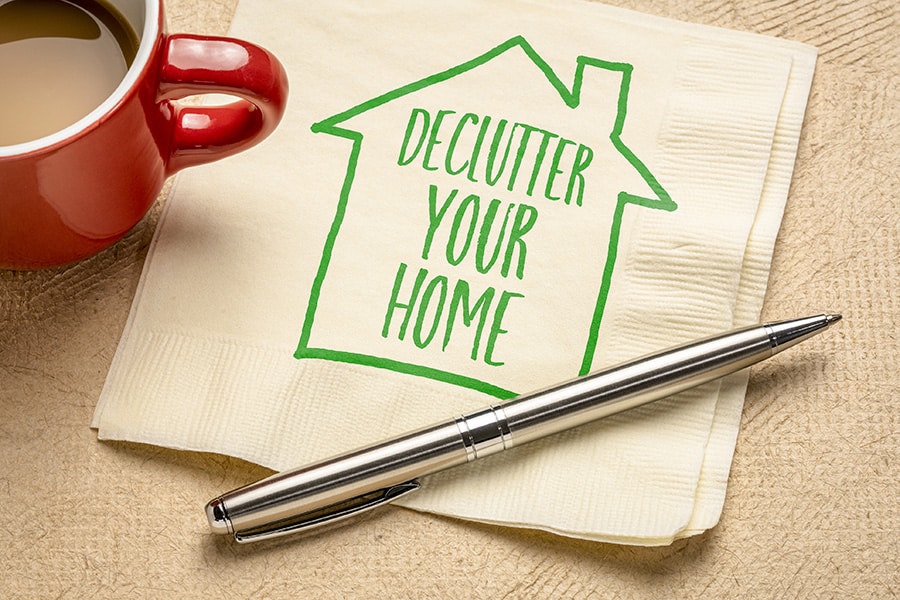
Introduction: Emotion vs. Reason
When conversing with real estate agents, you will often find that when they talk to you about buying real estate, they will refer to your purchase as a “home.” Yet if you are selling property, they will often refer to it as a “house.” There is a reason for this. Buying real estate is often an emotional decision, but when selling real estate you need to remove emotion from the equation.You need to think of your house as a marketable commodity. Property. Real estate. Your goal is to get others to see it as their potential home, not yours. If you do not consciously make this decision, you can inadvertently create a situation where it takes longer to sell your property.The first step in getting your home ready to sell is to “de-personalize” it.
De-Personalize the House
The reason you want to “de-personalize” your home is because you want buyers to view it as their potential home. When a potential homebuyer sees your family photos hanging on the wall, it puts your own brand on the home and momentarily shatters their illusions about owning the house. Therefore, put away family photos, sports trophies, collectible items, knick-knacks, and souvenirs. Put them in a box. Rent a storage area for a few months and put the box in the storage unit.Do not just put the box in the attic, basement, garage or a closet. Part of preparing a house for sale is to remove “clutter,” and that is the next step in preparing your house for sale.
Removing Clutter, Though You May Not Think of it as Clutter
This is the hardest thing for most people to do because they are emotionally attached to everything in the house. After years of living in the same home, clutter collects in such a way that may not be evident to the homeowner. However, it does affect the way buyers see the home, even if you do not realize it. Clutter collects on shelves, counter tops, drawers, closets, garages, attics, and basements.
Take a step back and pretend you are a buyer. Let a friend help point out areas of clutter, as long as you can accept their views without getting defensive. Let your agent help you, too.
Kitchen Clutter
The kitchen is a good place to start removing clutter, because it is an easy place to start. First, get everything off the counters. Everything. Even the toaster. Put the toaster in a cabinet and take it out when you use it. Find a place where you can store everything in cabinets and drawers. Of course, you may notice that you do not have cabinet space to put everything. Clean them out. The dishes, pots and pans that rarely get used? Put them in a box and put that box in storage, too.
You see, home buyers will open all your cabinets and drawers, especially in the kitchen. They want to be sure there is enough room for their “stuff.” If your kitchen cabinets, pantries, and drawers look jammed full, it sends a negative message to the buyer and does not promote an image of plentiful storage space. The best way to do that is to have as much “empty space” as possible.
For that reason, if you have a “junk drawer,” get rid of the junk. If you have a rarely used crock pot, put it in storage. Do this with every cabinet and drawer. Create open space.
If you have a large amount of foodstuffs crammed into the shelves or pantry, begin using them – especially canned goods. Canned goods are heavy and you don’t want to be lugging them to a new house, anyway – or paying a mover to do so. Let what you have on the shelves determine your menus and use up as much as you can.
Beneath the sink is very critical, too. Make sure the area beneath the sink is as empty as possible, removing all extra cleaning supplies. You should scrub the area down as well, and determine if there are any tell-tale signs of water leaks that may cause a home buyer to hesitate in buying your home.
Closet Clutter
Closets are great for accumulating clutter, though you may not think of it as clutter. We are talking about extra clothes and shoes – things you rarely wear but cannot bear to be without. Do without these items for a couple of months by putting them in a box, because these items can make your closets look “crammed full.” Sometimes there are shoe boxes full of “stuff” or other accumulated personal items, too.
Furniture Clutter
Many people have too much furniture in certain rooms – not too much for your own personal living needs – but too much to give the illusion of space that a home buyer would like to see. You may want to tour some builders’ models to see how they place furniture in the model homes. Observe how they place furniture in the models so you get some ideas on what to remove and what to leave in your house.
Storage Area Clutter
Basements, garages, attics, and sheds accumulate not only clutter, but junk. These areas should be as empty as possible so that buyers can imagine what they would do with the space. Remove anything that is not essential and take it to the storage area. Or have a garage sale.

